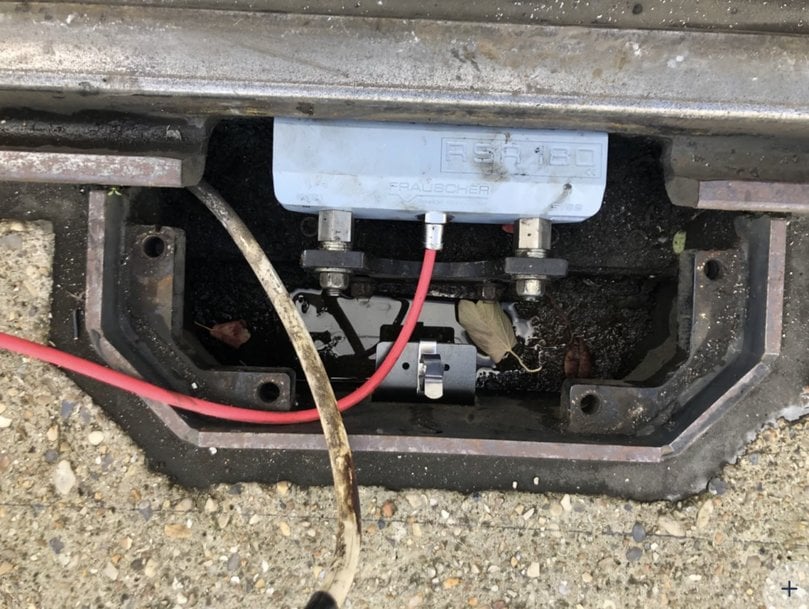railway-international.com
21
'24
Written on Modified on
Embedded Rail Signalling – A Case for Frauscher Axle Counters
In busy cities and urban environments, embedded railroad tracks have become a familiar sight, often being seamlessly integrated into the roads and pathways, making them an integral part of the modern urban landscapes.

Whether walking, riding a bicycle, or navigating the streets by car, many individuals frequently traverse embedded railroad tracks without realising this.
Embedded Rail and Why It Is Used
The use of embedded rail is essential in a number of cases, such as at intersections where railroad tracks intersect with roads, or where light rail lines and streetcars coexist with vehicular traffic. The utilisation of standard railroad tracks, commonly referred to as tee-rail, in such locations could potentially lead to a wide array of problems, such as excessive noise pollution, accelerated wear and tear on both rails and automobiles, increased risks of tripping hazards for pedestrians, and heightened danger for cyclists, among many others.
From an installation standpoint, embedded rails are encased within the pavement in cast-in-place concrete, except for the tops and gauge sides of the rails. The tracks are flush with the surrounding surface, offering a secure connection that allows for safe and smooth operation of light rail, streetcars, and any type of grade crossing.
While embedded rail is necessary in many urban contexts, it does present some difficulties when it comes to signaling systems. Because the rail is encased in concrete, it can be difficult to utilise conventional signaling systems that rely on electrical conductivity for train detection. The fact that a sizable number of rail lines are powered by overhead catenary can also pose additional issues.
Frauscher Axle Counters and the SK420 – Ideal Solution for Embedded Rail
Frauscher axle counting systems provide signaling technology that can address common issues associated with the use of embedded rails, thanks to robust wheel sensors that have been designed to accommodate this unique rail type.
Frauscher wheel sensors are resistant to negative effects from environmental and weather issues such as heavy rain, snow, ice, road salt, and extreme temperatures that may cause issues for other types of signaling systems. All Frauscher wheel sensors are waterproof and IP68 rated, giving them the ability to continue operating even after being submerged in water for extended periods. This could occur during extreme rain and flooding where the drainage system cannot fully keep up with the volume of water, or if the box itself has no drainage system. In this example, the system continued to work without interruption even after the wheel sensors were submerged in water for an extended period.
The SK420 design
In standard rail applications, Frauscher wheel sensors are clamped to the rail using our rail claw with no drilling required for installation; however, the rail claw that is used with standard rail is not suitable for embedded rail. For this reason, a special rail claw called the SK420 was designed for use in these special applications.
With the SK420, the entire rail claw and wheel sensor unit is housed in a box that is installed at grade, flush with the road surface. Embedded track has a groove in the rail, also called a channel, which is designed for the wheel flange to pass through. During installation, the channel is cut or notched to allow the wheel sensor to detect the wheel flange. Finally, the wheel sensor unit is protected from car and pedestrian traffic by a street level cover, rated to handle an axle load of 44 tons (40 metric tons).
Since the requirements for embedded rail applications vary widely, there are several design options available for the SK420, and two primary methods of attaching the unit to the rail. The first is a clamp-on version, and the second option is to weld the unit to the rail. The SK420 unit has a drainage tube available that can be connected to a drainage system to keep water from collecting in the unit. The sensor cable goes through a connector that attaches to the signaling cable, which in turn connects to the axle counter equipment.
Electromagnetic Interference (EMI) Issues
Many rail systems are powered by overhead catenary, which can cause interference with electronic or magnetic based signaling systems. Frauscher wheel sensors are inductive as opposed to magnetic, making our sensors highly resistant to EMI issues resulting from overhead catenary or other common electronic interferences. When using the SK420, it is permissible to isolate around the box to keep stray currents from the catenary within the rail. Frauscher wheel sensors are tested against the highest level of EMI and traction return currents.
In addition to these features and benefits of a Frauscher system using the SK420 for embedded rail, Frauscher axle counters also have additional special functions available that further support availability. Read more about the Frauscher Advanced Counter FAdC features.
Frauscher Embedded Rail Expertise
Since its inception over 35 years ago, Frauscher has operated with a strategic goal of meeting customer needs through innovative product design and updates to existing products. The SK420 was designed to accommodate signaling complications that can result from the unique requirements of embedded rail, with more than 5,000 SK420 units installed and proven globally.
As Frauscher’s presence in the North American rail market continues to increase, our products and expertise have led to many exciting and unique opportunities to implement our embedded rail system. After several successful embedded rail projects, we have seen a marked increase in requests from both transit and freight operators throughout the US and Canada to implement the SK420 system. Our goal is to provide signaling operations that perform at the highest level of efficiency, with a special focus on these specialized embedded rail applications. Such an examples include Houston Metro Line.
www.frauscher.com

